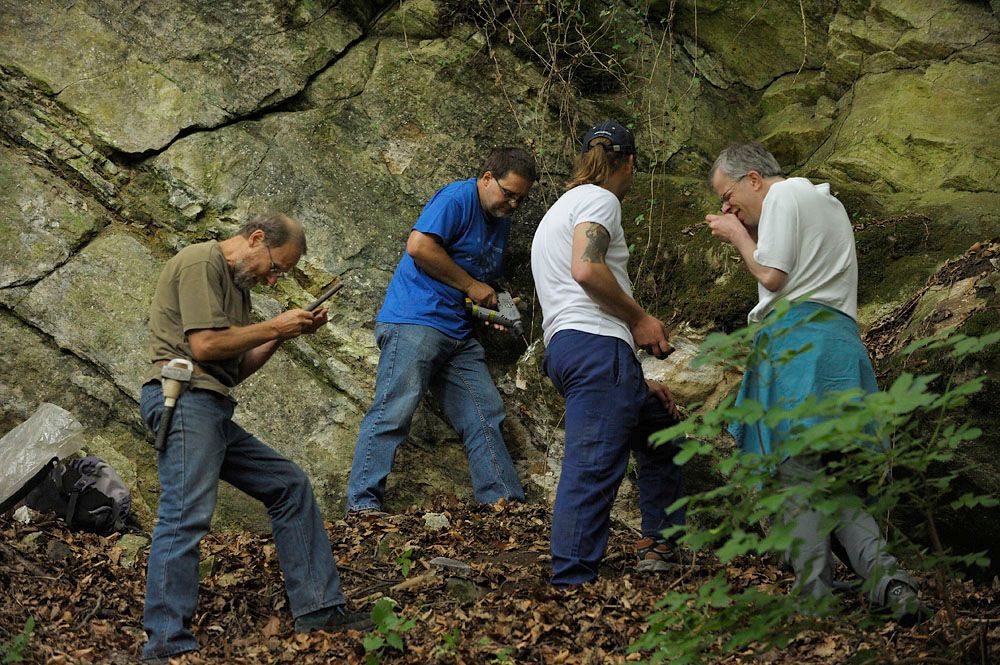Burgring 7,
1010 Wien
Mineral deposits in Austria
Austria is rich in a wide range of mineral deposits. Precise documentation of both “old” deposits (e.g. mining heaps and tunnels, slag heaps) and “new” location spots (e.g. quarries, natural outcrops, road cuts, etc.) is one of the focuses of the Department of Mineralogy and Petrography at the Natural History Museum Vienna. This can be achieved only with the help of mineral collectors, amateur mineralogists and members of the general public interested in mineralogy who collect minerals and make them available to scientific experiments. The outstanding collaboration with collectors with regard to documenting mineralogy in Lower Austria (“NÖ mineral database”) and Vorarlberg should be expanded to other federal states. Tyrol in particular is still relatively unexplored in comparison to other federal states.

© Harald Schillhammer
Who can participate?
Mineral collectors, amateur mineralogists and members of the general public who are interested in mineralogy.
Time period
The project is running for an unspecified period.
Where?
Across all of Austria (especially Tyrol).
What data is needed?
Citizen scientists can support research by collecting minerals and documenting mineral discoveries, as well as providing samples for mineralogical analyses. The results of scientific analyses will usually be published in popular scientific publications (in German) (e.g. as “Neue Mineralfunde aus Österreich” [New minerals found in Austria] in the journal “Carinthia II” or, more rarely, in the journals “Der Steirische Mineralog”, “Der Aufschluss”, “Mineralien-Welt” or “Lapis”), whereby the project manager sends the final article to all participants in PDF format. Articles in “Carinthia II” generally become open access one year after publication, which means that anyone can download them for free.
Shortly after publication, the project manager will enter the new mineral analyses in all publications, together with meaningful photos, into freely accessible international mineral and mineral location databases, such as Mindat (in English) and Mineralienatlas - Fossilienatlas (in German).
The publications are often written in co-authorship with the finder, especially if they provided important information through good documentation of the discovery and circumstances of finding, or through research into literature in archives and by surveying residents at the location.
Exceptional scientific results will also be published in international, English-language scientific journals.
Examples of popular science publications from recent years are:
- Journal "Carinthia II": Neue Mineralfunde aus Österreich LXV (2016) [PDF]
- Journal "Carinthia II": Neue Mineralfunde aus Österreich LXVI (2017) [PDF]
- Die Mineralogie der weltweit einzigartigen Schlacken von Waitschach, Kärnten [The mineralogy of globally unique slag from Waitschach, Carinthia] [PDF]
- Kolitsch, U. & Slama, M. (2016): Zur Mineralogie des niederösterreichischen Anteils des Semmering-Basistunnels: ein erster Bericht. [Mineralogy of the Lower Austrian part of the Semmering Base Tunnel: a first report] Der Steirische Mineralog 31, 20-27. [PDF on e-mail request]
- several individual contributions in: Walter, F., Auer, C., Bernhard, F., Bojar, H.-P., Brandstätter, F., Grill, J. A., Kiseljak, R., Knobloch, G., Kolitsch, U., Lamatsch, P., Lenz, C., Löffler, E., Melcher, F., Postl, W., Prasnik, H., Rausch, L., Reicht, M., Schachinger, T., Schillhammer, H., Schreieck, E., Schwabl, S., Steck, C., Steiner, T., Trattner, W. & Weißensteiner, G. (2020): Neue Mineralfunde aus Österreich LXIX. Carinthia II, 210./130., 153-218. [PDF]
How can I take part?
If you are interested and/or want to take part, please contact:
Priv.-Doz. Dr. Uwe Kolitsch
This email address is being protected from spambots. You need JavaScript enabled to view it.
This project fulfils version 1.1 of the quality criteria for citizen science projects on Österreich forscht.
- geology

